Solved Examples
36.1 a solenoid of length 10 cm and radius 1 cm contains 200 turns and carries a current of 10 A. Find the magnetic field at a point on the axis at a distance of 10 cm from the centre.
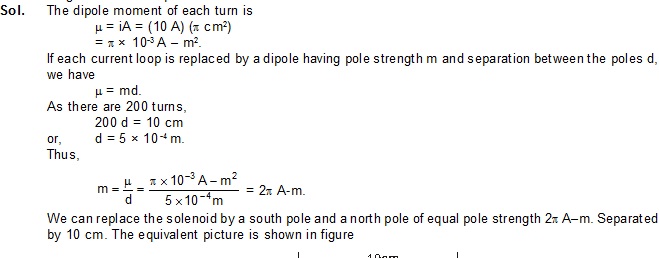


36.2 A bar magnet having a magnetic moment of 1.0 × 104 J/T is free to rotate in a horizontal plane.
A horizontal magnetic field B = 4 × 10 -5 T exists in the space. Find the work done in rotating the magnet
slowly from a direction parallel to the field to a direction 600 from the field.

36.3 A magnet is 10 cm long and its pole strength is 120 CGS units (1 CGS unit of pole strength = 0.1 A-m).
Find the magnitude of the magnetic field B at a point on its axis at a distance 20 cm from it.

36.4 Find the magnetic field due to a dipole of magnetic moment 1.2 A–m2 at a point 1 m
away from it in a direction making an angle of 600 with the dipole- axis.
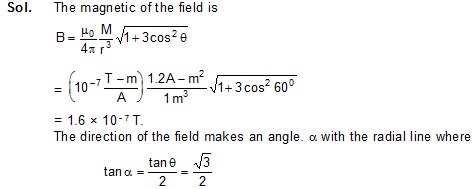
36.5 The horizontal component of the earth’s magnetic field is 3.6 × 10-5 T where the dip is 600.
Find the magnitude of the earth’s magnetic field.

36.6 At 450 to the magnetic meridian, the apparent dip is 300. Find the true dip.

36.7 A tangent galvanometer has 66 turns and the diameter of its coil is 22 cm. It gives a deflection
of 450 for 0.10 A current. What is the value of the horizontal component of the earth’s magnetic field ?
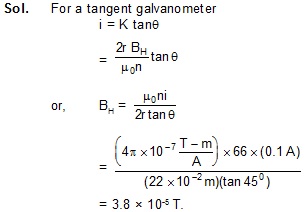
36.8 A galvanometer having a coil of resistance 20 W needs 20 mA current for full-scale deflection.
In order to pass a maximum current of 2 A through the galvanometer, what resistance should be added as a shunt ?
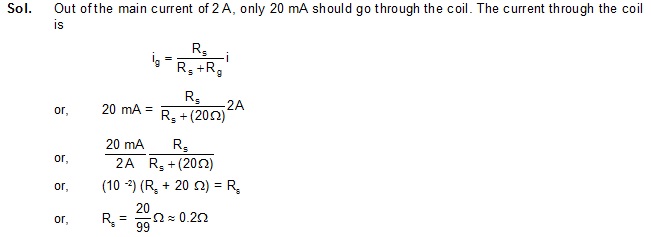
36.9 A compass needle oscillates 20 times per minute at a place where the dip is 450 and 30 times
per minute where the dip is 300. Compare the total magnetic field due to the earth at the two places.
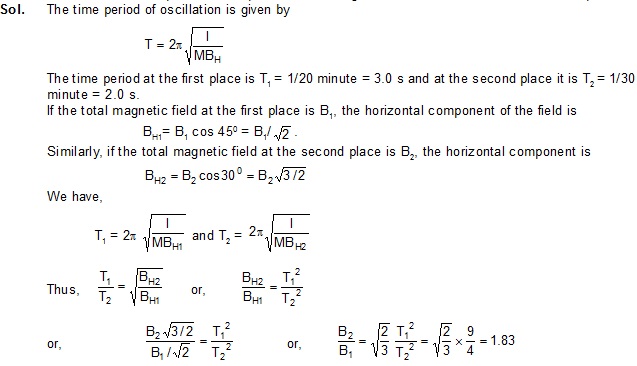
Questions for Short answer
1. Can we have a single north pole ? A single south pole ?
2. Do two distinct poles actually exist at two nearby points in a magnetic dipole ?
3. An iron needle is attracted to the ends of a bar magnet but not to the middle region of the magnet.
Is the material making up the ends of a bar magnet different from that of the middle region ?
4. Compare the direction of the magnetic field inside a solenoid with that of the field there if the
solenoid is replaced by its equivalent combination of north pole and south pole.
5. Sketch the magnetic field lines for a current-carrying circular loop near its centre. Replace the loop
by an equivalent magnetic dipole and sketch the magnetic field lines near the centre of the dipole.
Identify the difference.
![]()
that a magnetic field can exert forces only perpendicular to itself ?
7. Two bar magnets are placed close to each other with their opposite poles facing each other.
In absence of other forces, the magnets are pulled towards each other and their kinetic energy increase.
Does it contradict our earlier knowledge that magnetic forces cannot do any work and hence cannot
increase kinetic energy of a system ?

9. Can the earth’s magnetic field be vertical at a place ? What will happen to a freely suspended
magnet at such a place ? What is the value of dip here ?
10. Can the dip at a place be zero ? 900 ?
11. The reduction factor K of a tangent galvanometer is written on the instrument. The manual says that
the current is obtained by multiplying this factor to tanq. The procedure works well at Bhuwaneshwar.
Will the procedure work if the instrument is taken to Nepal ? If there is some error, can it be corrected
by correcting the manual or the instrument will have to be taken back to the factory ?
Objective - I
1. A circular loop carrying a current is replaced by an equivalent magnetic dipole. A point on the axis of the loop is in
(A*) end-on position (B) broadside-on position (C) both (D) none
2. A circular loop carrying a current is replaced by an equivalent magnetic dipole. A point on the loop is in
(A) end-on position (B*) broadside-on position (C) both (D) none
3. When a current in a circular loop is equivalenty replaced by a magnetic dipole,
(A) the pole strength m of each pole is fixed (B) the distance d between the poles is fixed
(C*) the product md is fixed (D) none of the above

6. Two short magnets of equal dipole moments M are fastened perpendicuarly at their centres (fig.)
The magnetic fo the magnetic field at a distance d from the centre on the bisector of the right angle is
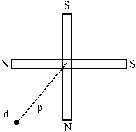

7. Magnetic meridian is
(A) a point (B) a line along north-south (C) a horizontal plane (D*) a vertical plane
8. A compass needls which is allowed to move in a horizontal plane is taken to a gemoagnetic pole. It
(A) will stay in north-south direction only (B) will stay in east-west direction only
(C) will become rigid showing no movement (D*) will stay in any position.
9. A dip circle is taken to geomagnetic equator. The needle is allowed to move in a vertical plane perpendicular
to the magnetic meridian. The needle will stay
(A) in horizontal direction only (B) in vertical direction only
(C) in any direction except vertical and horizontal (D*) in any direction it is released
10. Which of the following four graphs may best represent the current-deflection relation in a tangent galvanometer?
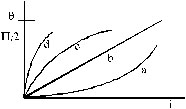
(C*)
11 A tangent galvanometer is connected directly to an ideal battery. If the number of turns in the coil is doubled, the deflection will
(A) increase (B) decrease (C*) remain unchanged (D) either increase or decrease
12. If the current is double, the deflection is also doubled in
(A) a tangent galvanother (B*) a moving-coil galvanometer (C) both (D) none
13. A very long bar magnet is placed with its north pole concilding with the centre of a circular loop carrying an electric current i.
The magnetic field due to the magnet at a point on the periphery of the wire is B. The radius of the loop is a. The force on the wire is
(A*) very nearly 2paiB perpendicular to the plane of the wire (B) 2paiB in the plane of the wire
(D) paiB along the magnet (D) zero
Objective - II
1. Pick the correct options.
(A*) Magnetic field is produced by electric charges only
(B*) Magnetic poles are only mathematical assumptions having no real existence.
(C) A north pole is equivalent to a clockwise current and a south pole is equivalent to an anticlockwise current
(D) A bar magnet is equivalent to a long, straight current
2. A horizontal circular loop carries a current that looks clockwise when viewed from above.
It is replaced by an equivalent magnetic dipole consisting of a south pole S and a north pole N.
(A) The line SN should be along a diameter of the loop.
(B*) The line SN should be perpendicular to the plane of the loop
(C) The south pole should be below the loop.
(D*) The north pole should be below the loop
3. Consider a magnetic dipole kept in the north-south direction. Let P1, P2, Q1, Q2 be four points
at the same distance from the dipole towards norht, south, east and west of the dipole respectively.
The directions of the magnetic field due to the dipole are the same at
(A*) P1 and P2 (B*) Q1 and Q2 (C) P1 and Q1 (D) P2 and Q2
4. Consider the situation of the previous problem. The directions of the magnetic
field due to the dipole are opposite at
(A) P1 and P2 (B) Q1 and Q2 (C*) P1 and Q1 (D*) P2 and Q2
5. To measure the magnetic moment of a bar magnet, one may use
(A) a tangent galvanometer
(B*) a deflection galvanometer if the earth’s horizontal field is konwn
(C*) an oscillation magnetometer if the earth’s horizontal field is konwm
(D*) both deflection and oscillation magnetometer if the earth’s horizontal field is not known.
Worked Out Examples
1. A bar magnet has a pole strength of 3.6 A–m and magnetic length 8 cm. Find the magnetic field at
(a) a point on the axis at a distance of 6 cm from the centre towards the north pole and
(b) a point on the perpendicular bisector at the same distance.
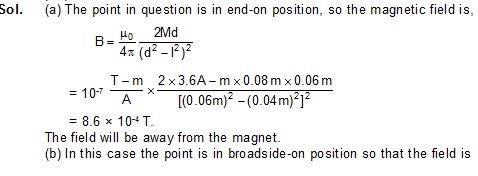
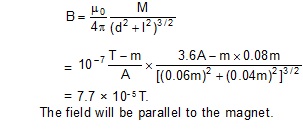
2. A magnet is suspended by a vertical string attached to its middle point. Find the position in which the
magnet can stay in equilibrium. The horizontal component of the earth’s magnetic field = 25 mT and it
vertical component = 40 mT. Assume that the string makes contact with the magnet only at a single point.

As the tension and the force of gravity act through the centre, their torque about the centre is zero.
To make the net torque acting on the magnet zero, it must stay in the direction of the resultant magnetic field.
Hence, it stays in the magnetic meridian making an angle of 580 with the horizontal.
3. A magnetic needle having magnetic moment 10 A–m2 and length 2.0 cm is clamped at its centre in
such a way that it can rotate in the vertical east-west plane. A horizontal force towards east is applied at
the north pole to keep the needle fixed at an angle of 300 with the vertical. Find the magnitude of
the applied force. The vertical component of the earth’s magnetic field is 40 mT.
Sol. 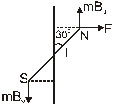

4. The magnetic scalar potential due to a magnetic dipole at a point on its axis situated at a distance
of 20 cm from its centre is found to be 1.2 × 10-5 T-m. Find the magnetic moment of the dipole.
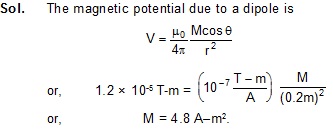
5. A bar magnet of magnetic moment 2.0 A–m2 is free to rotate about a vertical axis through its centre.
The magnet is released from rest from the east-west position. Find the kinetic energy of the magnet
as it takes the north-south position. The horizontal component of the earth’s magnetic field is B = 25T.
Sol. The magnetic potential energy of the dipole in a uniform magnetic field is given by U = – MB

6. Figure shows two idential magnetic dipoles a and b of magnetic moments M each, placed at a separation d,
with their axes perpendicular to each other. Find the magnetic field at the point P midway between the dipoles.


7. A bar magnet of length 8 cm and having a pole strength of 1.0 A–m is placed vertically on a horizontal table
with its south pole on the table. A neutral point is found on the table at a distance of 6.0 cm north of the magnet.
Calculate the earth’s horizontal magnetic field.
Sol. 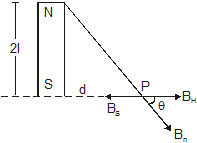
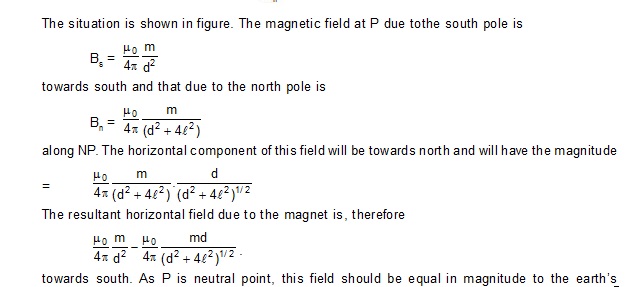
.
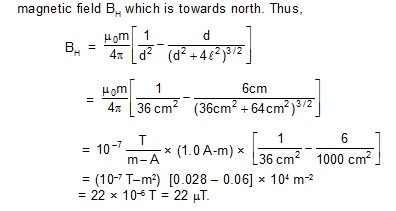
8. The magnetic field at a point on the magnetic equator is found to be 3.1 × 10–5 T. Taking the earth’s
radius to be 6400 km, calculate the magnetic moment of the assumed dipole at the earth’s centre.
Sol. 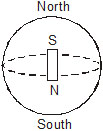

9. The earth’s magnetic field at geomagnetic poles has a magnitude 6.2 × 10–5 T. Find the magnitude
and the direction of the field at a point on the earth’s surface where the radius an angle of 135º with
the axis of the earth’s assumed magnetic dipole. What is the inclination (dip) at this point ?
Sol. 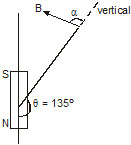

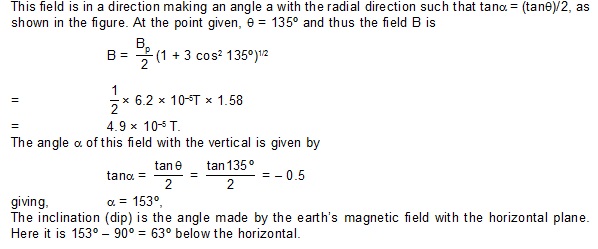
10. A magnetic needle free to rotate in a fixed vertical plane stays in a direction making an angle 60º
with the horizontal. If the dip at that place is 37º, find the angle of the fixed vertical plane with the meridian.

11. A dip circle shows on apparent dip of 60º at a place where the true dip is 45º. If the dip circle is
rotated through 90º, what apparent dip will it show ?
 .
.
12. A magnetic needle of length 10 cm, suspended at its niddle point through a thread,stays at an angle
of 45º with the horizontal. The horizontal component of the earth’s magnetic field.
(a) Find the vertical component of this field. (b) If the pole strength of the needle is 1.6 A–m, what vertical
force should be applied to an end so as to keep it in horizontal position.
Sol. (a) 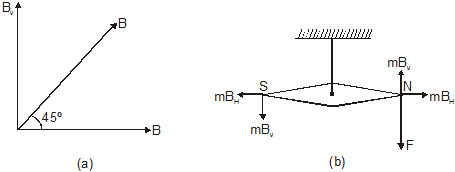
![]()
tan 45º= BV / BH
or BV = BH = 18 T.
(b) When the force F is applied (figure), the needle stays in horizontal position.
Taking torque about the centre of the magnet,
2mBV × 1 = F × l
or F = 2mBV
= 2 × (1.6 A–m) × (18 × 106 T)
= 5.8 × 10–5 N.
13. A tangent galvanometer has a coil 100 turns and each turn has an area 2.0 cm2.
The magnetic field produced by the magnet is 0.01 T. The deflection in the coil is 0.05
radian when a current of 10 mA is passed through it. Find the torsioal constant of the suspension wire.
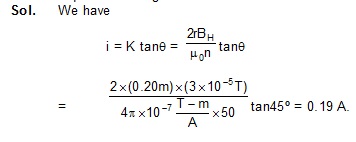
14. A moving–coil galvanometer has 100 turns and each turn has an area 2.0 cm2. The magnetic
field produced by the magnet is 0.01 T. The deflection in the coil is 0.05 radian when a current
of 10 mA is passed through it. Find the torsional constant of the suspension wire.
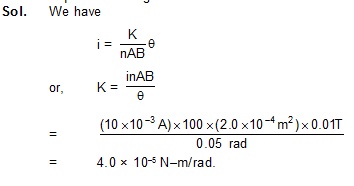
15. A galvanometer coil has a resistance of 100 W. When a current passes through the galvanometer,
1% of the current goes through the shunt. Find the resistance of the shunt.
Sol. 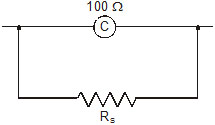

16. The needle of a deflection magnetometer deflects through 45º from north–south when the
instrument is used in Tan. A postion with a magnet of length 10 cm placed at a distance of 25 cm.
(a) Find the magnetic moment of the magnet if the earth’s horizontal magnetic field is 20 mT.
(b) If the magnetometer is used in Tan–B position with the same magnet at the same separatioin
from the needle, what will be the deflection ?
Sol. (a) Tan–A position, the needle is in end–on position of the magnet so that the field at the needle
due to the magnet is
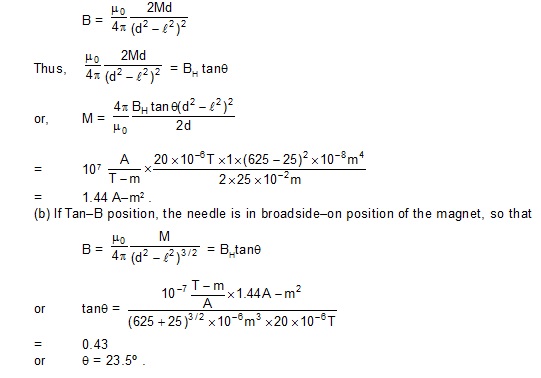
17. Figure shows a short magnet executing small oscillations in an oscillation magnetometer in earth’s magnetic
field having horizontal component 24 mT. The time period of oscillation is 0.10 s. An upward electric current
of 18 A is established in the vertical wire placed 20 cm east of the magnet by closing switch S.
Find the new time period.
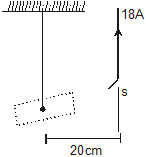
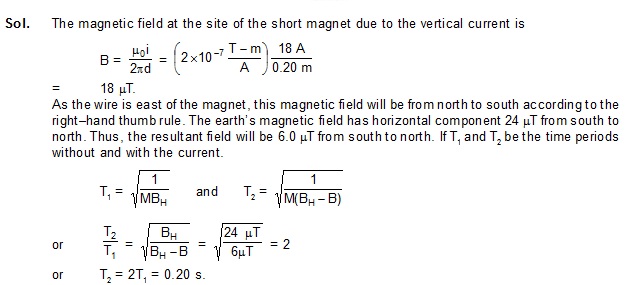
18. The frequency of oscillation of the magnet in an oscillation magnetometer in the earth’s magnetic field is
40 oscillations per minute. A short bar magnet is placed to the north of the magnetometer, at a separation
of 20 cm from the oscillating magnet, with its north pole pointing towards north(figure). The frequency of
oscillation is found to increase to 60º oscillations per minute. Calculate the magnetic moment of this short
bar magnet. Horizontal component of the earth’s magnetic field is 24 mT.
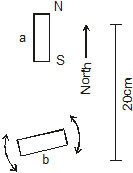
Sol. Let the magnetic field due to the short magnetic field due to the short magnet have magnitude B at the
site of the oscillating magnet. From the figure , this magnetic field will be towards north and hence the
resultant horizontal field will be BH + B. Let M and M’ denote the magnetic moments of the oscillating
magnet and the other magnet reslpectively. If c and v’ be the frequencies without and with
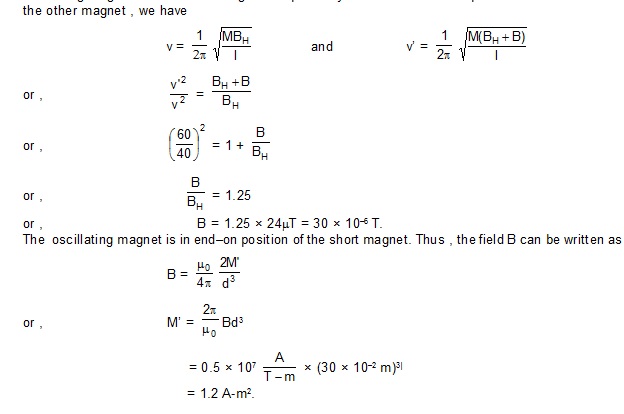
19. A bar magnet of mass 100g , length 7.0 cm, width 1.0 cm and height 0.50 cm takes pie /2 senonds to
complete an oscillation in an oscillation magnetometer placed in a horizontal magnetic field of 25 mu T.
(a) Find the magnetic moment of the magnet . (b) If the magnet is put in the magnetometer with its
0.50cm edge horizontal , what would be the time period ?
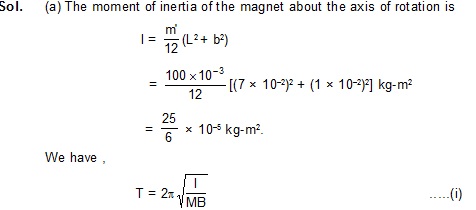
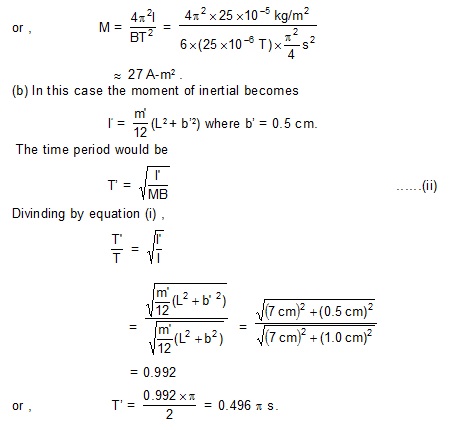
Exercise
1. A long bar magnet has a pole strength of 10 A–m. Find the magnetic field at a point on the
axis of the magnet at a distance of 5cm from the north pole of the magnet.
Ans: 4 × 10 – 4 T
2. Two long bar magnets are placed with their axes coinciding in such a way that the north pole
of the first magnet is 2.0 cm from the south pole of the second . If both the magnets have a
pole strength of 10 A–m, find the force exerted by one magnet on the other.
Ans: 2.5 × 10 – 2 N
3. A uniform magnetic field of 0.20 × 10 – 3 T exists in the space. Find the change in the
magnetic scalar potential as one moves through 50cm along the field.
Ans: Decreases by 0.10 × 10 – 3 T – m
4. Figure (36 - E1) shows some of the equipotential surfaces of the magnetic scalar potential.
Find the magnetic field B at a point in the region.
Ans: 2.0 × 10 – 4 T
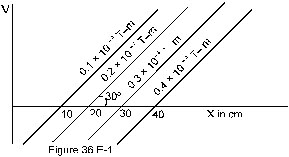
5. The magnetic field at a point 10 cm away from a magnetic dipole, is found to be 2.0 × 20 – 4 T.
Find the magnetic moment of the dipole if the point is (a) in end - on position of the dipole and
(b) in broadside- on position of the dipole .
Ans: (a) 1.0 – m 2 and (b) 2.0 A – m 2
7. A bar magnetic has a length of 8cm. The magnetic field at a point at a distance 3cm from the centre
in the broadside on position is found to be 4 × 10 – Bita T. Find the pole strength of the magnet.
Ans: 6 × 10 – 5 A-m
8. A magnetic dipole of magnetic moment 1.44 A – m 2 is placed horizontally with the north pole pointing
towards north. Find the position of the neutral point if the horizontal component of the earth ‘s magnetic field is 18 µ T.
Ans: at a distance of 20 cm in the plane bisecting the dipole
9. A magnetic dipole of magnetic moment 0.72 A – m 2 is placed horizontally with the north pole pointing
towards south. Find the position of the neutral point if the horizontal component of the earth ‘s magnetic field is 18 µ T
Ans: 20 cm south of the dipole

11. The magnetic moment of the assumed dipole at the earth’s centre is 8.0 × 10 22 A – m 2.
Calculate the magnetic field B at the geomagnetic poles of the earth. Radius of the earth is 6400 km.
Ans: 60 µ T
12. If the earth’s magnetic field has a magnitude 3.4 × 10 – 5 at the magnetic equator of the earth,
what would be its value at the earth’s geomagnetic poles ?
Ans: 6.8 × 10 – 5 T
13. The magnetic field due to the earth has a horizontal component of 26µ T at a place where the
dip is 60º. Find the vertical component and the magnitude of the field.
Ans: 45 µ T, 52 µ T

Ans: 30º
15. The needle of a dip circle shows an apparent dip of 45º in a particular position and 53º when
the circle is rotated through 90º Find the true dip.
Ans: 39º
16. A tangent galvanometer shows a deflection of 45º when 10mA of current is passed through it.
If the horizontal component of the earth’s magnetic field is BH = 3.6 × 10 – 5 T and radius of the coil is
10 cm, find the number of turns in the coil.
17. A moving -coil galvanometer has a 50 turn coil of size 2 cm × 2 cm. It is suspended between the
magnetic poles producing a magnetic field of 0.5 T Find the torque on the coil due to the magnetic
field when a current of 20 mA passes through it.
Ans: 2 × 10 – 4 N–m
18. A short magnet produces a deflection of 37º in a deflection magnetometer in Tan-A position when
placed at a separation of 10 cm from the needle. Find the ratio of the magnetic moment of the magnet
to the earth ‘s horizontal magnetic field.

19. The magnetometer of the previous problem is used with the same magnet in Tan - B position.
where should the magnet be produce a 37º deflection of the needle?
Ans: 7.9 cm from the centre
20. A deflection magnetometer is placed with its arms in north-south direction How and where
should a short magnet having M/BH = 40 A – m 2 / T be placed so that the needle can stay in any position ?
Ans: 2.0 cm from the needle, north pole pointing towards south
21. A bar magnet takes p/10 second to complete one oscillation in an oscillation magnetometer
The moment of inertia of the magnet about the axis of rotation is 1.2 × 10 – 4 kg – m 2 and the earth’s
horizontal magnetic field is 30 µ T .Find the magnetic moment of the magnet.
Ans: 1600 A–m 2
22. The combination of two bar magnets makes 10 oscillations per second in an oscillation magnetometer
when like poles are tied together and 2 oscillations per second when unlike poles are tied together
find the ratio of the magnetic moment of the magnets .Neglect any induced magnetism.
Ans: 13 : 12
23. A short magnet oscillates in an oscillation magnetometer with a time period of 0.10 s where the earth
‘s horizontal magnetic field is 24 µ T. A downward current of 18 A is established in a vertical wire
placed 20 cm east of the magnet. Find the new time period.
Ans: 0.076s
24. A bar magnet makes 40 oscillations per minute in an oscillation magnetometer. An identical magnet is
demagnetized completely. and is placed over the magnet in the magnetometer. Find the time taken for
40 oscillations by this combination. Neglect any induced magnetism.
![]()
25. A short magnet makes 40 oscillations per minute when used in an oscillation magnetometer at a place
where the earth’s horizontal magnetic field is 25 µ T. Another short magnet of magnetic moment 1.6 A – m 2
is placed 20 cm east of the oscillations magnet. Find the new frequency of oscillation if the magnet has its
north pole (a) towards north and (b) towards south.
Ans: (a) 18 oscillations /minute (b) 54 oscillations/ minute